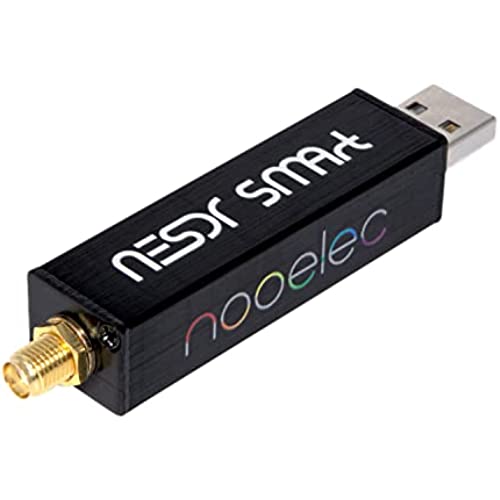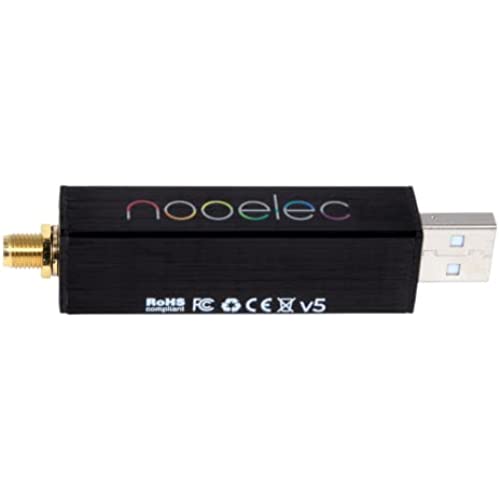











Nooelec RTL-SDR v5 SDR - NESDR Smart HF/VHF/UHF (100kHz-1.75GHz) Software Defined Radio. Premium RTLSDR w/ 0.5PPM TCXO, SMA Input & Aluminum Enclosure. RTL2832U & R820T2 (R860)-Based Radio
-

Taylor
Greater than one weekgreat form factor
-

Phillip Littlefield
> 3 dayThis thing is GREAT. I am running op25 for p25 reception. My previous SDRs were so drifty and unstable that on digital signals they were worthless. I plugged this one in and it just worked, right out of the box. Thanks for a good product.
-

Bob Arizona
> 3 dayFirst off I have been a ham radio operator since the 80s and hold an extra class (top) rating. I was looking for a very portable scanner that I could take along on my travels to listen to airline frequencies (also a private pilot) that wouldnt take up a lot of space in my full under seat bag nor look suspicious while in the airport, as a standard scanner might. The good news is that it does work, the bad news is that there are some limitations. The idea of slapping a small antenna on it and plugging into a cell phone or tablet with an OTG adapter is not feasible. The main issue is that the SDR radio draws more power than the OTG via the usb port can deliver. Solution, purchase a powered USB cable. This allows you to plug one end into a charging battery, which I always travel with, which powers the radio and doesnt drain the phone or tablet. https://www.amazon.com/Degree-Angled-Female-Enhancer-Adapter/dp/B071X8BCFH/ref=sr_1_3?keywords=powered+usb+cable+otg&qid=1552141974&s=gateway&sr=8-3 Then you will need an extension USB cable to the phone or tablet so you can place the unit in suitable position, and any adapters to your particular phone, USB to C, etc. Easily done and not expensive. Then there is the antenna! The beauty of this Radio is that it is extremely wide band covering below commercial FM to 1.700 Ghz or more. This covers most of the commercial bands including Aircraft, first respondeners, most walkie talkie and even cell phones. Note that many systems on those bands are encrypted and not easily monitored. The beautiful thing about this SDR radio is the spectrum display, or waterfall which will show you a chunk of the band and all the active frequencies. You are able to simply slide your virtual vernier to a hot spot and monitor the frequency. In addition there is a running visual display of all the activity on that part of the spectrum so you can see frequencies with intermittent activity. You also can easily select all the common radio modulation schemes, like AM, FM, FM narrow, amateur radio SSB USB, LSB and CW, etc. Of course, you will need an antenna and unfortunately antennas are tuned to the frequencies you want to listen to. Very critical if you are transmitting, less so for receiving. For example, international ham radio frequencies have a wave length of around 65 feet (20 meters) the length of a full wave antenna. 1/4 wave antennas also work at approximately 16 feet. Not practical to carry around plus you will need an additional adapter (Ham it up) to receive the lower frequencies. On the other hand a 1700 MX signal close to the top end of LTE cellphone data as a full wave length of 6. For receiving a wide band scanner antenna is probably your best bet like: https://www.amazon.com/AEcreative-Wide-Band-Scanner-BCD396XT-BCD436HP/dp/B07HWLSNQP/ref=sr_1_8?crid=3RCJLW4EP4MW&keywords=wideband+scanner+antenna&qid=1552143429&s=electronics&sprefix=wide-band+scanner+antenna+%2Celectronics%2C205&sr=1-8 When looking for an antenna you will need an SMA female connector. Lastly, you will need software for your phone, tablet or computer. Some of it is open source and free (donation) and others have a demo version and a small fee ($5-10) for the Android / IOS versions. Try before you buy! All in all a great product with serious applications.
-

Douglas miller
> 3 dayBought two from Amazon. One arrived fine and works fantastic. Much better temperature stability than any others Ive had. That part I love! The other was DOA, and Amazon quickly sent me a replacement. But when I plugged it into my laptop it fried not only itself, but the laptop too, which is now junk. Good thing it was an old laptop. I have a feeling my experience is not normal, so Ill rate it 3 stars. If I could somehow get two working at the same time, Id certainly rate it higher. The one I have Id give a five, easy. Its really good. Im sorely tempted to order another one and hope for better luck. But, well, who knows...
-

WA2HQN
> 3 daytest ryry
-

G. Saffer
> 3 dayThis is everything it was advertised to be. Well built, 0 frequency drift, more sensitive than my older R820T2 set up. Almost, but not quite as good as my Airspy which cost much more. It works very well as the Voice Channel dongle in my DSD+ trunk set up. It does get warm, but just a bit warmer than the Airspy which is a much bigger enclosure. An update since Ive had some experience with the dongle now. Frequency drift varies widely by frequency. On 935-939.000 Mhz trunking frequencies correction is in fact 0.0. The same seems to be true at 450-480.000 Mhz. At 152.000 Mhz following a NEXEDGE trunking system, 55.5 ppm correction is needed. Thats not terrific news, but the good news is that the drift and correction needed are predictable. The heat issue isnt all that significant. My Airspy runs cooler, but its about four times the size and thus has a lot more surface area for cooling. All of that being said, I still recommend it.
-

Terry Meier
> 3 dayLiked the display on my computer monitor.
-

Don
> 3 dayI am using the NESDR as a panadapter with my ham Yaesu FT450D transceiver. I installed a first IF buffer board and rear panel connector on the FT450D. When connected to this dongle, using HDSDR software, this allows the HDSDR software to display a wideband view around the tuned frequency on the transceiver. The device works very well for the purpose. The TXCO temperature compensated oscillator really improves the frequency stability over a cheaper bare-bones device. This insures the frequency displayed on the transceiver and the panadapter agree. The problem with this model is that the four USB contacts within the metal USB connector shell are set too far back from the tip of the connector. The mating socket makes insufficient contact for a reliable connection. The slightest movement of the dongle or extension cable will disconnect the device from the computer. Contact is very intermittent. This problem was on any USB socket or extension cable. Other users have reported the same issue. I contacted Nooelec. While they were somewhat helpful, they seemed unaware of the issue. I finally resolved the problem on my own by filing a few millimeters off of the end of the USB connector with a flat file. This allows the connector on the dongle to insert farther into the socket making reliable connection. No more disconnects.
-

JP
> 3 dayNice product, although no documentation was provided. Had to look up how to setup on the internet. Some difficulty in getting the software to recognize this SDR due to driver issues. Receive sensitivity could be better. Hooked up to outdoor scanner antenna. Still not receiving signals as strong as my ham radio.
-

Amazing Customer
> 3 dayI bought multiple. Unfortunately,I was sent one unit that was DOA, but they immediately replaced it, so kudos to them for excellent customer service. I then ran it through some tests and noticed some things. On just about every band, it was more sensitive than the RTL-SDR v3, and I was quite impressed.... until I hit 770 Mhz. There is a point, in the upper 700 Mhz band, where a lot of trunking radio systems are, that this unit is just plain deaf to. The unit outperformed the RTL-SDR V3 in every way, except that one crucial (to me) band segment. I had signals that were near full quieting on my other SDR that this one was barely able to receive. This happened with both units, so I just figured it was a design limitation. They were reassigned to a VHF trunked system to monitor, and have been doing quite well for a little over 2 years.... and now...*sigh*.... one of the units has crapped out, not being recognized by any USB port (which was the original mode of failure on the first one).... So, 1 failed immediately, and the replacement failed in 2 years with mild use (maybe 100 hours total). Theyre still a great deal, and if you have to buy a new one every 2 years its not that bad, but my next one will be from a different manufacturer. They are great for what they are, but they do have some limitations, just keep that in mind.
